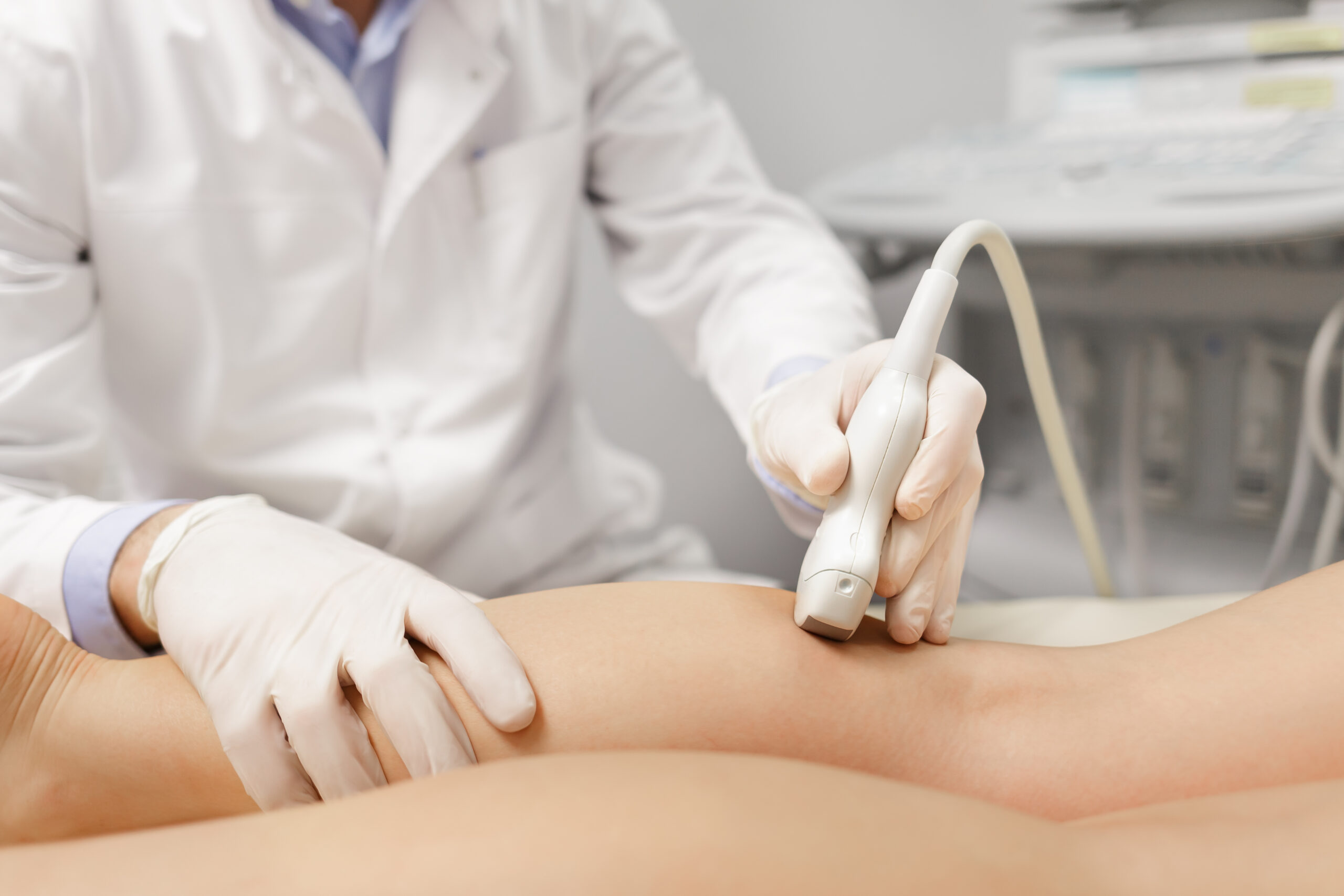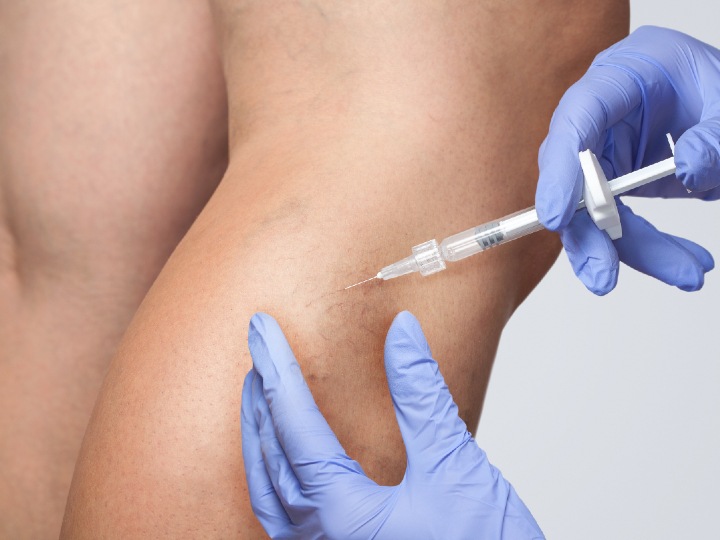
Radiofrequency Ablation (RFA) Varicose Veins Treatment
Radiofrequency (RF) Ablation is a leading minimally invasive varicose vein removal treatment. Here, we discuss the history and benefits of the treatment, along with procedure details and expected patient results.
What is Radiofrequency Ablation for Varicose Veins?
Radiofrequency Ablation (also known as RFA) was one of the very first modern-day methods to treat varicose veins. It uses radiofrequency thermal heat energy to shrink and close off the affected varicose veins. It emerged in the late 1990s and represented the start of a new wave of vein removal treatments that minimised patient recovery time and side effects. This revolutionary therapy avoided the painful side effects of traditional vein stripping while giving patients the chance to recover quickly, with minimal scarring.
The procedure was first carried out using a radiofrequency ablation device called the VNUS® Closure® device. Other devices have emerged since, including the RFiTT® device and the ClosureFast™ RFA System. Your consultant vascular surgeon can advise on if this varicose vein removal treatment is most suitable for you.

What does Radiofrequency Ablation mean?
Radiofrequency Ablation is an “endovenous” treatment for varicose veins. As a minimally invasive procedure, it is also sometimes known as “keyhole surgery.”
The treatment can be performed in clinic with no need for an overnight hospital stay. The word “endovenous” means ‘inside the vein,’ denoting how radiofrequency (RF) heat energy enters inside the vein to close it.
This heat ‘ablates’ or erodes the varicose vein by causing the faulty vein valves and vein walls to shrivel and naturally dissolve over time. This is why RFA is also known as “endovenous thermal ablation (EVTA). This term summarises how thermal heat is used to destroy the vein by causing its eventual fibrosis, absorption and natural dispersal from the human body.
Benefits of Radiofrequency Ablation
Radiofrequency ablation (RFA) is a tried-and-tested minimally invasive treatment with a track record for being low-risk and safe. The National Institute for Health and Care Excellence (NICE) guidelines recommended the treatment as an effective low-risk method to treat varicose veins in 2013, and a variety of clinical studies have since proven its efficacy. Thanks to its minimally invasive approach and quick treatment time, RFA has a range of key benefits:
- Walk-in, walk-out procedure
- Carried out as a day-case operation in an outpatient clinic
- Uses local anaesthetic rather than a general anaesthetic
- Requires one small incision at the site of the vein
- Less inflammation and discomfort
- Fast healing and treatment time
- Patients can resume normal activities immediately after treatment
- Effective results after 4-6 weeks of recovery
- Low infection risk
- Excellent long-term effectiveness
- No visible scar

What is the success rate for Radiofrequency Ablation?
There is a vast amount of medical literature and clinical studies that verify the success rate of radiofrequency ablation (RFA). It is an effective method in reducing varicose veins for a long duration, with several studies proving its long-term effectiveness. Two large-scale, multicentre studies followed RFA patients at 3 to 5 years after their treatments and discovered that 80% and 88% of patients were varicose-vein free at these two points. Another 15-year-long study showed that 88% of patients achieved success with no clinical occurrence of varicose veins since their original RFA treatments.
What veins can be treated with Radiofrequency Ablation?
Radiofrequency ablation treats varicose veins across multiple areas of the body. It is ideal for treating varicose veins in the legs, from small veins in the ankle to larger veins in the legs and thighs. A vein’s role is to carry blood to the heart, and valves exist along the vein length to ensure that blood flows in the right direction.
However, the leg valves must work harder against the force of gravity to ensure that blood flows upwards towards the heart. This can often lead to the valves becoming weak, which allows blood to flow backwards and collect in the vein (a process called venous reflux), making it swollen and varicose. The role of radiofrequency ablation (RFA) is to stop this reflux from happening by using thermal energy to seal off the damaged vein for good.
How does the Radiofrequency Ablation Vein Treatment work?
Radiofrequency ablation is a relatively quick and simple procedure to undertake, taking between 45 – 60 minutes in most cases. The first stage of having the procedure is the consultation, followed by the physical procedure itself.

The Consultation
During a clinical assessment with one of our specialist consultant vascular surgeons, we will analyse the current condition and location of your symptomatic varicose veins. This process is completed using our advanced colour duplex ultrasound scan, which gives our vascular surgeons a 3D visual analysis of the inside of your veins. This enables the vascular surgeon to identify the faulty vein valves and where they need to insert the radiofrequency ablation device to close off the damaged vein. There are some instances where a patient’s vein may not be suitable for this treatment, particularly if a patient has a vein that is scarred, or asymmetrical or if they feel another more advanced treatment would give a better result. In such instances, the consultant vascular surgeon may recommend another treatment like EVLA or VenaSeal to treat the varicose vein.
This personal consultation also gives you the chance to receive a detailed explanation of the procedure and ask any questions you may have about it. Your clinician will explain what to expect during the treatment, in addition to the expected success rate and treatment results. Once both parties are happy to proceed, the RFA procedure can take place.
The Radiofrequency (RF) Ablation Procedure
Radiofrequency ablation is a relatively straightforward treatment to remove varicose veins. Thermal heat energy damages the varicose vein walls, which causes the collagen within the vein wall to shrink which prevents blood from flowing through the vein. This blocks blood from flowing through the valve, thereby sealing it off completely.
To do this, the surgeon will insert a tiny catheter tube into the targeted vein through a small puncture, which the doctor will make using a small scalpel. This puncture wound is so small that scarring will not occur after the procedure. Anaesthetic eases any potential pain during this time.
The surgeon then uses ultrasound guidance to direct the RFA needle through the catheter tube. Radiofrequency energy then shrinks and dissolves the varicose vein walls through a tiny electrode.
The damaged vein later disintegrates, before being absorbed and removed by the body through natural metabolic processes. The blood that used to flow through the treated vein will also naturally redirect itself through healthy vein arteries, allowing the patient to be free from the symptoms of enlarged, bulging and swollen vein arteries.
Radiofrequency Ablation Vein Results
Visible improvements are often instantly noticeable after the treatment takes place. Once the vein has closed up and died, patients will benefit from visible improvements, less swelling and pain and a marked reduction in their previous varicose vein symptoms like burning and throbbing sensations. After 1-2 weeks, patients are likely to see and feel the full benefits once the vein has been dissolved and removed from the body completely.

Radiofrequency Ablation Recovery
In-Clinic Aftercare
The varicose vein puncture site will be bandaged up immediately after treatment, and a compression stocking may be applied to aid the healing process. Patients are usually asked to wait in a recovery room for 15 minutes so that the vascular surgeon can monitor how the patient is feeling and when they are ok to leave the clinic.
Your vascular surgeon may ask you to walk around for a few minutes to see if you feel comfortable before letting you leave the treatment practice. Once the patient and vascular surgeon are both happy, the patient will be free to leave the clinic and return to the majority of their normal activities on the very same day. This happens in the majority of cases at The Private Clinic. However, the local anaesthetic will still be working for a few hours after treatment. So patients should avoid driving and instead arrange for transportation to take them home.
At-Home Aftercare
Once home, treated patients should ideally rest for several days before returning to physical activities. This is to aid the healing process while helping to stimulate a quick recovery. Patients can use an ice pack to numb any pain or swelling that may occur at the treatment injection site a few days after. Ice pack treatments for 15 to 20 minutes at a time can be beneficial. But breaks must be taken for a few hours in between to allow for adequate skin recovery. Patients should avoid using heat packs to treat any pain or swelling that may occur.
Patients should also avoid showers for 1-2 days after treatment to prevent infection at the injection site. You may feel pain for 1 to 3 weeks after the treatment has taken place. However, this can be minimised by taking over-the-counter analgesics.
Depending on the condition of your treated vein, your surgeon may also advise you to walk frequently and avoid sitting or standing for long periods immediately after your procedure. This is to aid circulation and encourage healing. Patients should be able to return back to all of their normal activities in just a few days after resting and recuperating.
Radiofrequency Ablation Side Effects
Every medical treatment has potential risks and side effects, which will be discussed with you during your consultation.
Many patients complete the treatment without any side effects. However, some patients may feel a superficial burning pain immediately after the procedure. This usually disperses when patients take pain relief. Some patients may also experience a slight numbness over the treatment area, with some bruising and swelling occurring. But by resting and following the aftercare guidance, these side effects should disappear after 1 to 2 weeks.

Radiofrequency Ablation at The Private Clinic
At The Private Clinic, we carry out over 7,000 varicose vein removal treatments each year. Seeking out a personalised consultation with our consultant vascular surgeons is the best way to gain reliable advice about our varicose vein treatments. As a multi-award-winning clinic with a 5-Star Trustpilot rating, we are renowned for our expertise and exceptional patient results. Our consultant vascular surgeons have been handpicked for their years of experience and their innovation in developing the UK’s best vein treatments. So you will be in the best of hands when opting for an varicose vein removal procedure with us.
To find out more about our varicose vein procedures, fill out our varicose vein online enquiry form. Alternatively, you can call us directly on 0333 920 2471. We have state-of-the-art clinics across the country, with locations in London Harley Street, Birmingham, Northampton and Bournemouth.




